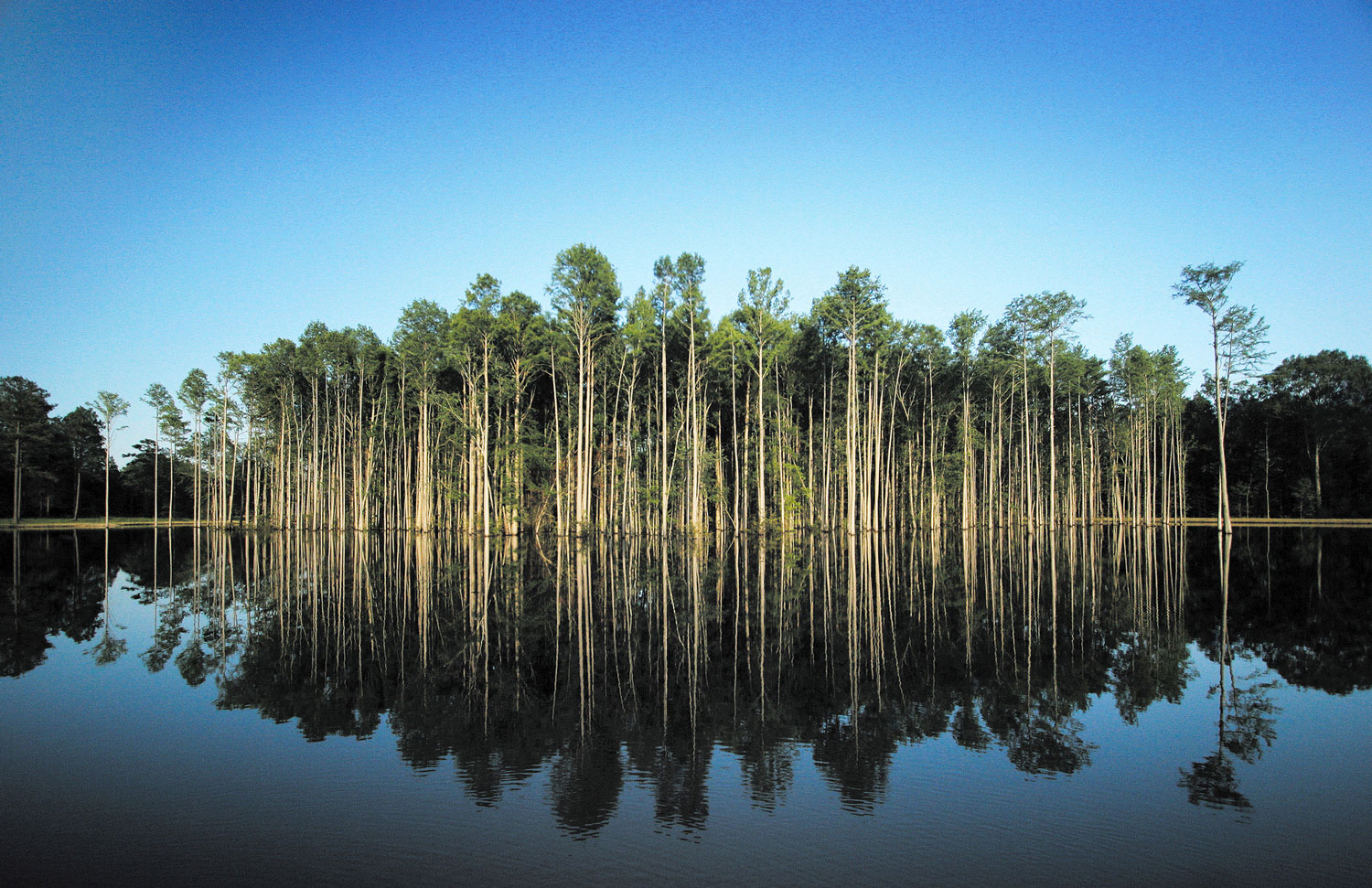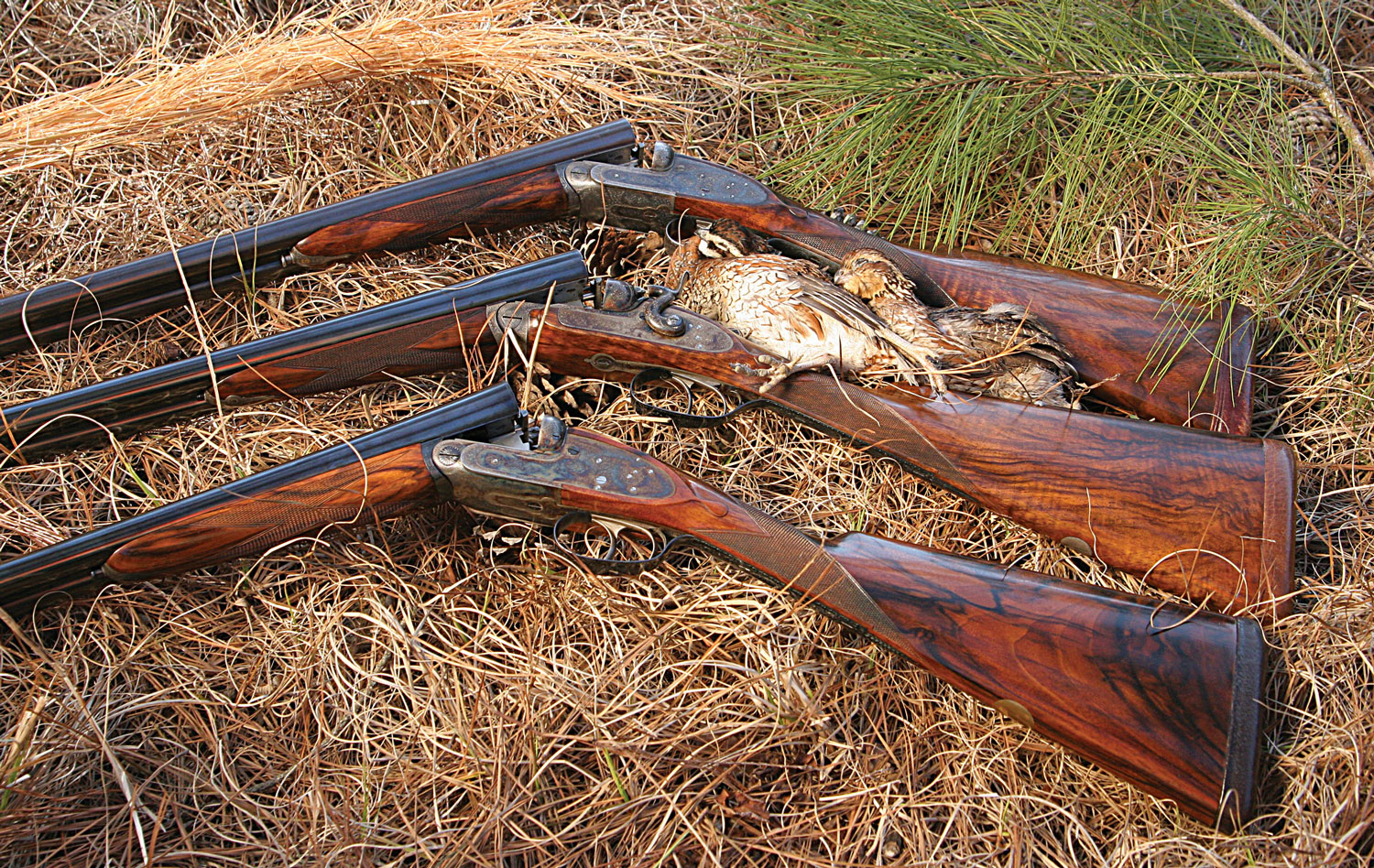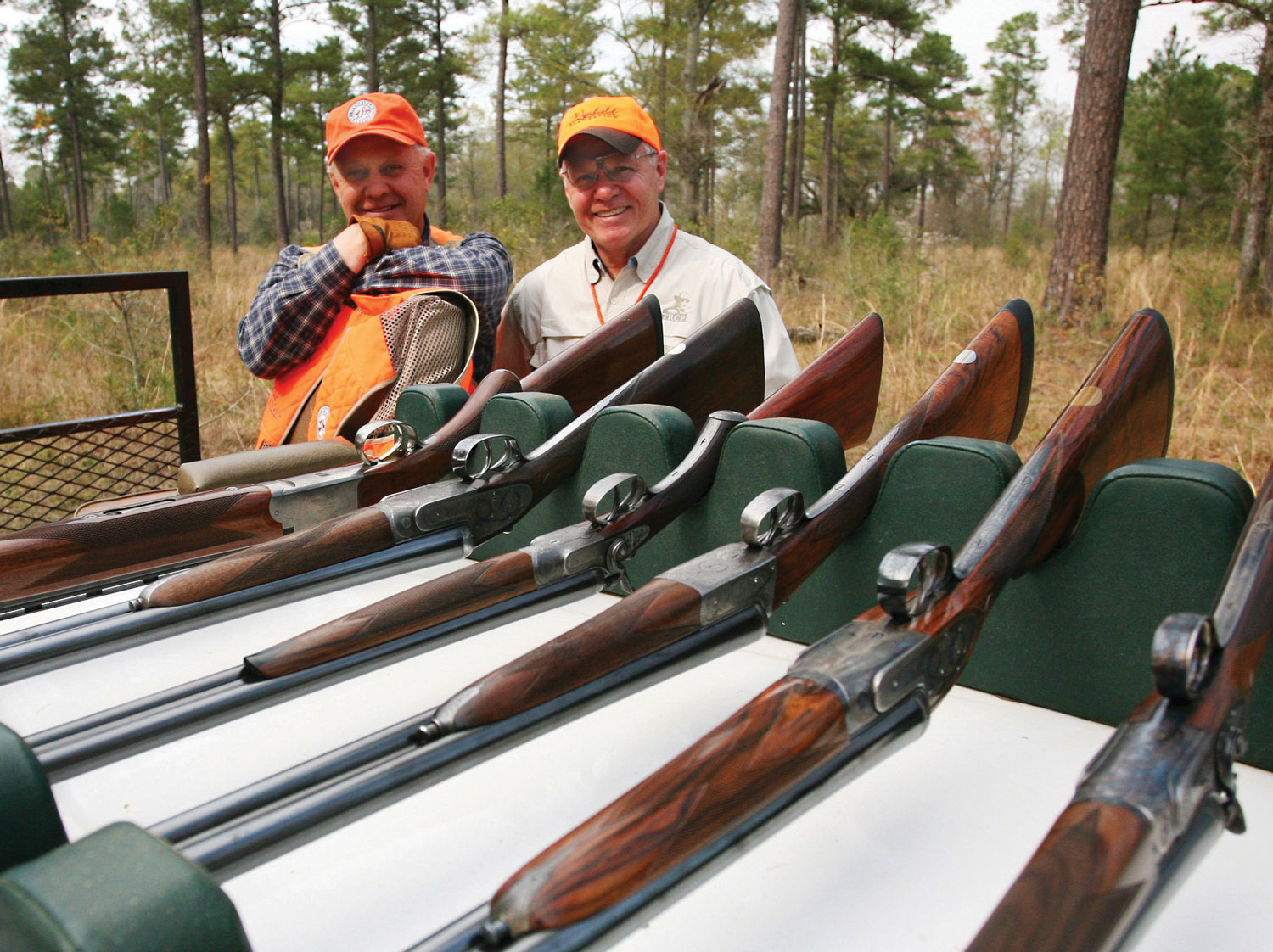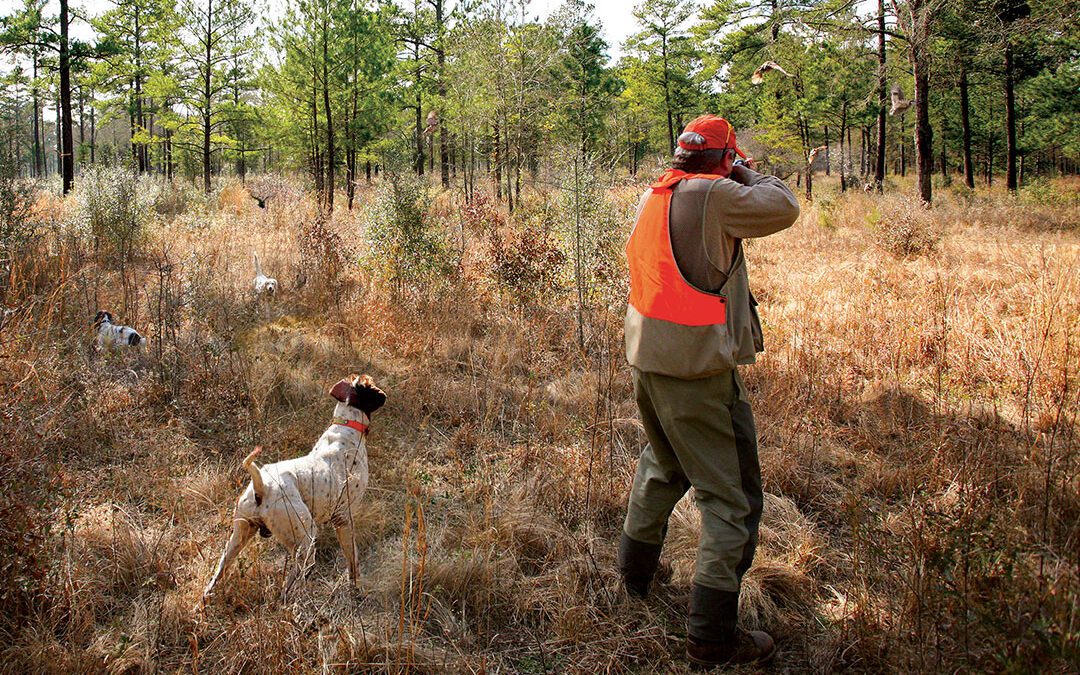Every time I head out for some far-flung destination like Quinhagak or Kinnakeet or Tierra Amarillo or the wilds of southern Georgia, it’s as though I were a kid again, riding high and happy beside my Dad, my excitement nearly more than I can contain. And now was such a moment.
I knew from the beginning that this trip was going to be good. The hunter’s moon was lowering full in my windshield as I left Tennessee and crossed into the Carolinas with the sun cresting the horizon to the east. Four hours later, I gathered up my shooting partner Bob Matthews in Hartwell, and that afternoon when we eased through the classic white gates of the old plantation down in southern Georgia, Chuck Wechsler was already there waiting for us.
Supper was served at 7:00 p.m. sharp, and we dined well and then made our way back to our private lodge. We sat up long past normal bedtime, much too excited to sleep, until Chuck finally called us all to our senses.
He and Bob headed off to their respective rooms. But I couldn’t resist a midnight walk down along the edge of the cypress lake before circling back through the starlit woods, and it was close to 2:00 a.m. before I finally drifted off to sleep amid dreams of breakfast and bird dogs and bobwhite quail.
Morning dawned cool and misty as the wizened winter sun peeked through the longleaf pines, unfurling long, lazy shafts of light through the forests and fog as dogs in the distant kennels began greeting their masters. Cee Turner, our longtime friend and guide, arrived right on time with the hunting vehicle, carrying the pointers and setters for the morning, and minutes later, we were boots-on-the-ground as our dogs Buck and Gal began weaving intricate patterns through the longleafs and sedge, with Rocket, a dashing little English cocker, close at heel alongside his master.
Bob and Chuck were up first, Chuck with his 20-gauge over/under and Bob with a new Italian double he had brought for us to test, each carrying a fresh pair of low-brass eights.
I followed, armed only with my cameras as the honey-hued light oozed through the pines and seeped through the sedge.
I had hunted here with little Gal seven years earlier when she was still a student. But now, it was she who was sharing her wealth of experience with Buck, a promising and precocious young pointer who suddenly came to rigid attention.
His tail was held high, his finely tuned nose set low into the subtle breeze, his whole body tensed to the point as Gal backed him approvingly from 20 yards. Then with the gunners in position, little Rocket was sent in for the flush.
The covey exploded from the thick wiregrass as guns and camera came up together, and within seconds Rocket and Gal were back at our sides with a bird apiece.
We made one fleeting cast for singles and then moved on in search of the next covey.
We never allow more than two gunners on the ground at a time, and I was perfectly content to continue photographing. But a half-mile farther on and two coveys later, Bob handed me his new test gun to try, then took my cameras to shoot some photos of his own as we eased into a lush stand of juvenile longleafs.
Their feathery tops were barely at eye level, their slender trunks lithe and yielding as we shouldered through them. Then suddenly, Gal locked up solid with young Buck backing her from ten yards. The cover was dense and our visibility was limited, so Chuck and I each shifted to opposite sides of the pines. When the covey broke, it broke in fragments, shattering to all points of the compass. Chuck and I fired at virtually the same instant, and his bird folded cleanly. My bird flinched at the shot and I fully expected him to fall—he should have fallen, for feathers hung floating in the air as my finger slid back past the front trigger.
But to my consternation, the fleeing bird barely broke stride as he tore through an angular shaft of sunlight and disappeared into the thick pines before I could manage a second shot. He emerged 60 yards away still going strong, silhouetted against the dark background of the bog beyond and much too far away to reach with my left barrel.
Still, I tracked him with my eyes, hoping he would fall. Then I saw Chuck off to my right, swinging smoothly on the bird as the reassuring report from his gun filled the air and the quail tumbled from the sky.
The remainder of the day was a true southern classic with the birds flying well, the dogs working to perfection, and the air as clean and pure as Miss Minnie’s intentions.
I eased down to the shoreline of the lake again that evening after Bob and Chuck had turned in. It was a cool, clear, moonless night, and as I looked across the still water, I could sense the looming cypress standing proud and dignified out in the center of the lake and could even see the stars at my feet reflecting from its calm, mirror surface. For a moment I presumed to hope that the day to follow would be as perfect as the one just lived. But the muted flashes of lightning through the ancient live oaks to the west told a different story.

The first raindrops began falling just past midnight, and at 12:20, the storm blew in. The lightning and thunder exhausted themselves by 2:30. Twice I arose during the night to see if there had been any change, but a cold and steady drizzle continued until first light, when again I quietly slipped outside to a soft and soggy stillness.
Gone was the staccato whisper of raindrops on the roof, replaced by the intermittent patter of water still dripping from the pines and live oaks, and from far across the lake again came the sweet, insistent greetings of bird dogs welcoming their masters as they arrived at the kennels. I roused my companions, and we wandered sleepily through the mist and down the gravel path to the main lodge for breakfast.
The beckoning aroma of hot coffee and the sizzling sounds of eggs and bacon and smoked sausages filled the room, while the morning glow filtered through foggy window panes as we shared our hopes for the day ahead. By 8:45, we had our gear in order, and Mr. Turner arrived at 9:00 with the dogs.
The air was heavy and cool, a perfect morning for fine dogs, fine birds and fine guns. So we broke out three Purdeys—Bob with his 1888 bar-in-wood hammergun, Chuck with a 1921 16-gauge, and I with my 1929 “Light Twelve” game gun with the Harry Kell engraving.

The sky hovered low and thin, and the morning light bathed the landscape in a tranquil, soothing softness. Bird scent hung close to the ground as we stepped into the still dripping woods, and soon the dogs were on their first point of the morning.
Bob and Chuck were up first as I followed with cameras ready and my gun open and empty. Rocket was released for the flush, and one lone quail rumbled from the wiregrass directly in front of Bob.
It was a terribly easy shot, a shot that even I could have made.
But to everyone’s amazement, brother Bob, a grizzled veteran of countless hunts around the world, swung on the hapless, waterlogged bird and promptly blew a hole through a nearby skein of Spanish moss, missing the quail completely. He didn’t even consider a follow-up shot.
I was stunned. I had never seen him blow such an easy opportunity, and as I searched for something to say, Chuck turned to him and proclaimed, “You were expecting a fast ball, Sundance, and he threw you a slow curve!”
It was at that moment as we all broke into laughter that the main covey began erupting in stages.
Some broke in groups, some as singles.
Bang! And one bird fell to Bob’s second barrel. Bang! Bang! And there were two more feathery puffs barely ten feet apart as Chuck doubled. They both quickly reloaded. Then a pair of birds veered high to our right and Bob dumped them both, and suddenly there were five—count ’em, five—trails of feathers hanging in the air around us.
Eventually the warming sun burned away the mist as the dogs continued turning up birds. It was as fine a day of quail hunting as any of us could recall. And as the afternoon light began to tend toward evening, Buck and Gal found one last covey.
Bob and I were up now as Chuck backed us with the camera. Looking a few yards out to the left, I could see Gal locked up on as steady a point as you’re ever likely to see. Glancing down I could see big Buck standing sculpted and still, close beside me, while a few feet to the right, little Rocket stood quivering at his master’s side until he was sent in for the flush.
A percussive thunder of wings filled the air as the covey erupted around us. Three birds blasted out to the left toward Bob, but the dogs conscientiously continued holding point as the main body came up directly in front of me. I swung on the farthest bird going dead away and he folded in a trail of feathers, while somewhere far to my left, Bob’s hammergun roared with conviction. Yet another brown blur appeared in front of my still-swinging barrels, tracking just above my first bird as he fell, and I only had to make a minor adjustment to center him as again Bob’s Purdey spoke in perfect two-part harmony with my own.
It was a moment of utter perfection—covey rising, dogs holding point, one bird dead in the air as you swing on another—a moment so exquisitely wrought as to border on the sublime, written in a language nearly unintelligible to mortal man.
For a few seconds, we all just stood there silently in the thick and pungent afterglow of wafting gun smoke as downy feathers drifted away on the wind, the only sounds the shuffle of the dogs returning through the sedge with our birds, the muffled thunder of our shots echoing through the distant pines, and the measured beat of hearts overflowing with one of the most immaculate moments any of us are ever again likely to experience.

Two of the author’s favorite accomplices, Bob Matthews (left) and Chuck Wechsler.
This is a story from Michael Altizer’s book NINETEEN YEARS TO SUNRISE, available at SportingClassicsStore.com—click on “BOOKS.” Or call 1-800-849-1004.
The author always welcomes and appreciates your comments, questions, critiques and input. Please keep in touch at Mike@AltizerJournal.com.
© MICHAEL ALTIZER per FNASR/FNADR Standards
Contact 1-423-341-8132 or 1-423-543-7881
Mike@AltizerCommunications.com

